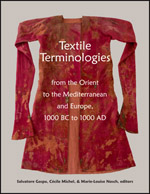Center, Textile Research

Textile Terminologies from the Orient to the Mediterranean and Europe, 1000 BC to 1000 AD
Date of this Version
2017
Document Type
Article
Citation
In Textile Terminologies from the Orient to the Mediterranean and Europe, 1000 BC to 1000 AD, ed. Salvatore Gaspa, Cécile Michel, & Marie-Louise Nosch (Lincoln, NE: Zea Books, 2017), pp. 164-172.
doi:10.13014/K2M32SZH
Abstract
Jewish law forbids Sha’atnez – wearing mixed wool and linen together was forbidden for the Jewish population. The article will first explain the meaning and acronym of sha’atnez, and then review the sha’atnez textiles which were found in the Land of Israel. The possible reasons for the prohibition of sha’atnez will be presented and remarks on observance and enforcement of the law in Orthodox Jewish communities today will be made according to ethnographic investigation.2
The concept of sha’atnez: Jewish law forbids sha’atnez – wearing garments of mixed wool and linen. This is mentioned twice in the Hebrew Bible: It is written in Leviticus 19:19, where it is stated that “you shall not put on cloth from a mixture of two kinds of material”. The prohibition of “the mixture of diverse kinds” of material is mentioned in additional contexts such as interbreeding different species of animals together, working different species of animals under the same yoke, and planting different species of seeds together in a single field. Sha’atnez garments are mentioned but the specific materials are not listed. In Deuteronomy 22:11, however, it is added that “You shall not wear cloth combining wool and linen”.
Sha’atnez applies only to sheep’s wool and linen. Any other combination of plant and animal fibres does not create sha’atnez, such as the combinations of cotton, silk, camel hair, mohair, hemp or nettle. The wool and linen may not be spun, woven, sewn, tied, knotted, or knitted together for garment use. Even one linen thread found in a large garment of wool renders the entire garment sha’atnez.3 Men and women are equally obligated in all the prohibitions of sha’atnez and it is also forbidden to clothe a child in sha’atnez garments.4
Included in
Ancient History, Greek and Roman through Late Antiquity Commons, Art and Materials Conservation Commons, Classical Archaeology and Art History Commons, Classical Literature and Philology Commons, Fiber, Textile, and Weaving Arts Commons, Indo-European Linguistics and Philology Commons, Jewish Studies Commons, Museum Studies Commons, Near Eastern Languages and Societies Commons, Other History of Art, Architecture, and Archaeology Commons


Comments
Copyright © 2017 Salvatore Gaspa, Cécile Michel, & Marie-Louise Nosch. Photographs copyright as noted.